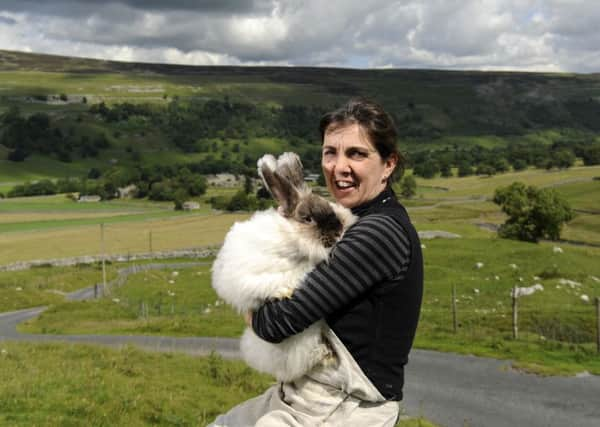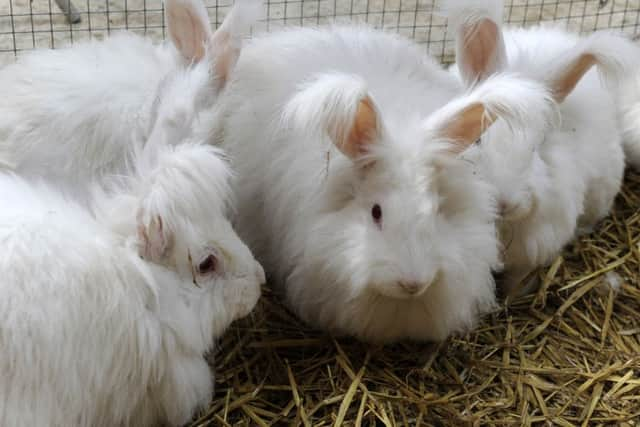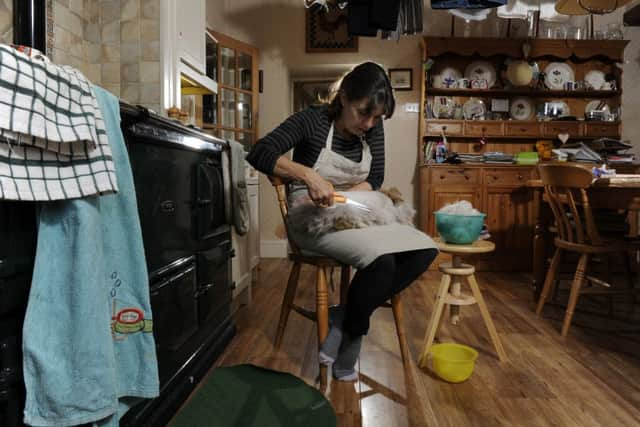A bunny way to make wool


This luxury yarn is much prized by hand knitters and textile artists for its lustrous sheen, extreme softness and outstanding heat retention. But harvesting the coats commercially is fraught with difficulty – so much so that Littondale farmer’s wife Sarah Paul is the county’s only commercial producer of Angora wool.
The bright and airy purpose-built shed next to her Arncliffe farmhouse is home to an extended family of 97 rabbits. At first sight they all seem enormous – but that’s until you spot the most recently shorn individuals, their fluffy heads looking oddly out of proportion with their newly slimmed-down bodies. Angoras really are nearly all hair.
Advertisement
Hide AdAdvertisement
Hide AdWith the exception of a recent import from Holland to diversify the gene pool, all are descended from one female matriarch but their coats range from shining white through cream and gold to agouti, grey and chocolate. But building up the colony has not been easy because Angoras don’t breed like, well, rabbits.


“They can be temperamental,” admits Sarah, “and at first I wanted as many colours as possible so I wasn’t selecting them rigorously. They don’t always like being caught either – but they do enjoy being groomed and find having a haircut relaxing.”
Whereas most show breeders favour the smaller English Angora, Sarah keeps the Continental varieties because of the higher proportion of guard hairs in the coat, which make it more manageable and silky. This quality was particularly prized by the French, while the Germans selected larger animals and favoured white coloration, greater quantities of fibre, tufty ears and hairy faces. During the Second World War Hitler developed a breeding programme to produce Angora for army uniforms. The legacy persists to this day with German manufacturers using the textile mainly for thermal clothing while the French make it into luxury garments.
At Bigwigs Angora most of Sarah’s females (or does) live in small family groups bedded on straw. The kittens huddle up together in nests lined with moulted hair while the males (or bucks) are mainly kept in separate pens to prevent them fighting. There are typically five to seven young in a litter and the oldest animals are currently six years of age although they can live for up to eight years. It takes seven hours a week to clean the pens and feed and water the rabbits, which live on a diet of high-protein pellets made from grass and herbs for optimal growth, supplemented by good meadow hay and porridge oats for babies and sickly adults or as a special treat. The appearance of their favourite foodstuff sends the animals stampeding towards their bowls, scrambling over each other with excitement.
Advertisement
Hide AdAdvertisement
Hide AdBut the hard work doesn’t end there. Because Angora hair grows about an inch a month, it needs cutting every 14 to 16 weeks so that the animals don’t suffer the discomfort of matted coats. A specialist pet blower removes any detritus from the fur and then Sarah carefully clips eight rabbits a week, snipping away at the coat in small sections using hand scissors so that it can be sorted by length. The longer hairs from the back and sides are ideal for hand spinning and yarn while those from the chest and rear end are used for felting.


It’s not a recipe for getting rich quick. Each rabbit takes one hour to clip, producing 100g of fibre – enough to make a jumper after blending with 300g of sheep’s wool. All the knotted fibres have to be carefully removed unless craftspeople ask for them to be retained for a felting project. Sarah admits that at the moment the business is a ‘hobby that pays for itself’ but it is an ethical alternative to cheap clothing from dubious sources.
In 2013 the campaigning charity People for the Ethical Treatment of Animals called on shoppers in the West to boycott high-street stores sourcing Angora from China, which produces 90 per cent of the world’s total output. Undercover videos showing rabbits cowering in tiny cages with bleeding, raw skin after their fur had been violently plucked shamed major retailers like Marks & Spencer and Next into removing all garments made with the material from their shelves.
Home producers may not be able to compete with China’s massive factory farms on price but Sarah is leading the way as one of a handful of specialist commercial businesses in the country. She now harvests enough fibre to send a batch to Farr Lacy Mill in Lincolnshire three or four times a year, where it is carded (or combed) and then blended with British Bluefaced Leicester or ethically sourced Merino wool before spinning. Because the rabbit hair is more smooth and hollow, it has insulating qualities and gives the yarn its lightness and warmth. It makes up 50 per cent of a luxury blend but adding just 25 per cent gives greater durability. The wool is available in natural shades or a selection of muted dyed colours produced from mixing natural Angora with Merino dyed at Europa Mills in Huddersfield, and costs from £9 per ball. Sarah also sells 25g bags of fibres for spinning and felting in white, sable, oatmeal, gold, silver, agouti and smoke.
Advertisement
Hide AdAdvertisement
Hide AdOver recent years interest from individual craftspeople has increased and Bigwigs Angora has had stalls at major festivals like the annual Woolfest in Cockermouth, Cumbria, and Wonderwool at the Royal Welsh Showground at Builth Wells. From 26 - 27 September Sarah will be exhibiting at the third Yarndale celebration at Skipton Auction Mart, which will bring together more than 180 artists and producers and is expected to attract 7,000 visitors. The free Tale of Two Festivals exhibition at the Craven Museum & Gallery in the town hall is showcasing the event until October 4.
But developing the business has not been without its setbacks. “I’m not a farmer’s daughter but I always wanted to work with animals,” says Sarah. “When we lived in Skipton, we didn’t have any land – just outbuildings. I used to raise guinea pigs and sell them to pet shops. I wanted to be a farmer but my parents said I needed a qualification so I went to agricultural college. Then I saw a programme on television and found an advert for a lady in Keighley who kept Angoras.”
After leaving college, Sarah spent a year in Australia and had 30 rabbits when she first arrived in Arncliffe. She worked at the Falcon Inn while taking a rural business ventures course and converted a room overlooking the village green into a craft shop. This provided an outlet for the Angora and she joined a co-operative of producers, who pooled their fibre so that they had enough for it to be spun.
But then she married, started a family, and the market fell away with the introduction of microfleeces in the late ’80s and early ’90s. With four young children to bring up, the remaining wool was hidden away in the attic until 2009.
Advertisement
Hide AdAdvertisement
Hide AdThen, with more time on her hands as her family grew up and increased space after a move to a larger farm down the road, she resumed production. Even so, it took two years to build up enough fibre for the first commercial spin – and the business still has to compete with many other commitments. As well as a part-time job with a walking holiday company, Sarah lets a holiday cottage and helps around the farm in busy periods like haytime and lambing.
You would think there would be no time for leisure – but in her spare moments Sarah uses her own Angora wool to create wrist warmers, scarves and baby clothes.
It may be one of the oldest crafts around but as more and more people rediscover the delights of hand knitting, this energetic trailblazer is introducing the beauty of Angora to a new generation.
• For more information visit www.bigwigsangora.co.uk, call 01756 770282 or email [email protected]